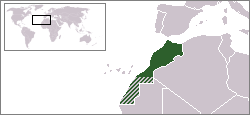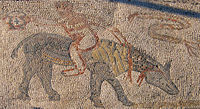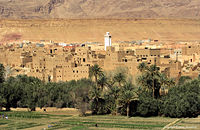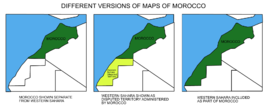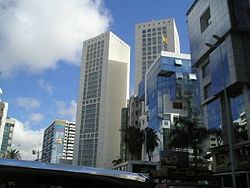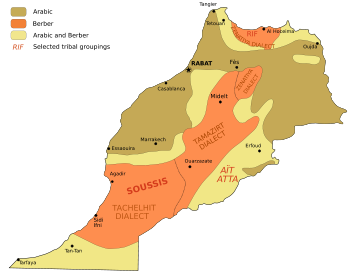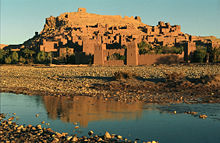Morocco
2008/9 Schools Wikipedia Selection. Related subjects: Africa; African Countries
| المملكة المغربية Al-Mamlaka al-Maghribiyya Kingdom of Morocco
|
||||||
|---|---|---|---|---|---|---|
|
||||||
| Motto: "Allāh, al Waţan, al Malik" ( transliteration) "God, Nation, King" |
||||||
| Anthem: " Hymne Chérifien" |
||||||
|
The striped area on the map shows Western Sahara, most of which is de facto administered by Morocco as its " Southern Provinces". Its sovereignty, however, is currently in dispute.
|
||||||
| Capital | Rabat |
|||||
| Largest city | Casablanca | |||||
| Official languages | Arabic, others commonly used unofficially. | |||||
| Demonym | Moroccan | |||||
| Government | Constitutional monarchy | |||||
| - | King | Mohammed VI | ||||
| - | Prime Minister | Abbas El Fassi | ||||
| Unification | 1554 | |||||
| - | Unified by Saadi dynasty | 1554 | ||||
| - | Alaouite dynasty (present) | 1666 | ||||
| - | Independence from France | March 2, 1956 | ||||
| - | Independence from Spain | April 7, 1956 | ||||
| Area | ||||||
| - | Total | 446,550* km² ( 57th) 172,414 sq mi |
||||
| - | Water (%) | 250km² | ||||
| Population | ||||||
| - | 2007 estimate | 33,757,175 ( 37th) | ||||
| - | Density | 70/km² ( 122nd) 181/sq mi |
||||
| GDP ( PPP) | 2006 estimate | |||||
| - | Total | $152.5 billion ( 54th) | ||||
| - | Per capita | $4,600 ( 109th) | ||||
| HDI (2007) | ▲ 0.646 (medium) ( 126th) | |||||
| Currency | Moroccan dirham ( MAD) |
|||||
| Time zone | WET ( UTC+0) | |||||
| - | Summer ( DST) | WEST ( UTC+1) | ||||
| Internet TLD | .ma | |||||
| Calling code | +212 | |||||
| *All data excludes Western Sahara, much of which is under Moroccan de facto administrative control. | ||||||
| 1 | French is widely used in the government in official texts, and in the business community, though neither instance is 'official.' Moroccan Arabic, an Arabic vernacular is the most common native language. Amazigh or Berber languages are also widely spoken. | |||||
Morocco (Arabic: المغرب "al-Maghrib"), officially the Kingdom of Morocco (Arabic: المملكة المغربية), is a country in North Africa with a population of 33,757,175. It has a coast on the Atlantic Ocean that reaches past the Strait of Gibraltar into the Mediterranean Sea. Morocco has international borders with Algeria to the east, Spain to the north (a water border through the Strait and land borders with two small Spanish autonomous cities, Ceuta and Melilla), and Mauritania to the south.
Morocco is the only African country that is not currently a member of the African Union. However, it is a member of the Arab League at present, Arab Maghreb Union, the Francophonie, Organization of the Islamic Conference, Mediterranean Dialogue group, and Group of 77, and is a major non-NATO ally of the United States.
Name
The full Arabic name Al-Mamlaka al-Maghribiya translates to "The Western Kingdom." Al-Maghrib (meaning "The West") is commonly used. For historical references, medieval Arab historians and geographers used to refer to Morocco as Al-Maghrib al Aqşá ("The Farthest West"), disambiguating it from neighboring historical regions called al-Maghrib al Awsat ("The Middle West", Algeria) and al-Maghrib al Adna ("The Nearest West", Tunisia).
The Latinized name "Morocco" originates from medieval Latin "Morroch," which referred to the name of the former Almoravid and Almohad capital, Marrakech. The Persians straightforwardly call it "Marrakech" while the Turks call it "Fas" which comes from the ancient Idrisid and Marinid capital, Fès.
The word "Marrakech" is presumably derived from the Berber word Mur-Akush meaning Land of God.
History
Berber Morocco
The area of present-day Morocco has been inhabited since Neolithic times (at least since 8000 BC, as attested by signs of the Capsian culture), a period when the Maghreb was less arid than it is today. Many theorists believe the Amazigh people, commonly referred to as Berbers or by their regional ethnic identity (e.g. Chleuh), probably arrived at roughly the same time as the inception of agriculture in the region. In the classical period, Morocco was known as Mauretania, although this should not be confused with the modern country of Mauritania.
Roman and pre-Roman Morocco
North Africa and Morocco were slowly drawn into the wider emerging Mediterranean world by Phoenician trading colonies and settlements in the late Classical period. The arrival of Phoenicians heralded a long engagement with the wider Mediterranean, as this strategic region formed part of the Roman Empire, as Mauretania Tingitana. In the fifth century, as the Roman Empire declined, the region fell to the Vandals, Visigoths, and then Byzantine Greeks in rapid succession. During this time, however, the high mountains of most of modern Morocco remained unsubdued, and stayed in the hands of their Berber inhabitants.
Medieval Morocco
By the seventh century, Islamic expansion was at its greatest. In 670 AD, the first Islamic conquest of the North African coastal plain took place under Uqba ibn Nafi, a general serving under the Umayyads of Damascus. His delegates went to what is now Morocco, which he called "Maghreb al Aqsa" or "The Far West," in the year 683. The delegates supported the assimilation process that took about a century.
What became modern Morocco in the seventh century, was an area of Berbers influenced by the Arabs, who brought their customs, culture, and Islam, to which most of the Berbers converted, forming states and kingdoms such as the Kingdom of Nekor and Barghawata, sometimes after long-running series of civil wars. Under Idris ibn Abdallah who founded the Idrisid Dynasty, the country soon cut ties and broke away from the control of the distant Abbasid caliphs in Baghdad and the Umayyad rule in Al-Andalus. The Idrisids established Fes as their capital and Morocco became a centre of learning and a major regional power.
After the reign of the Idrisids, Arab settlers lost political control in the region of Morocco. After adopting Islam, Berber dynasties formed governments and reigned over the country. Morocco would reach its height under these Berber dynasties that replaced the Arab Idrisids after the 11th century. The Almoravids, the Almohads, then the Marinid and finally the Saadi dynasties would see Morocco rule most of Northwest Africa, as well as large sections of Islamic Iberia, or Al-Andalus.
Alaouite Dynasty 1666–1912

After the Saadi, the Arab Alaouite Dynasty eventually gained control. Morocco was facing aggression from Spain and the Ottoman Empire that was sweeping westward. The Alaouites succeeded in stabilizing their position, and while the kingdom was smaller than previous ones in the region, it remained quite wealthy. In 1684, they annexed Tangier.
Morocco was the first nation to recognize the fledgling United States as an independent nation in 1777. In the beginning of the American Revolution, American merchant ships were subject to attack by the Barbary Pirates while sailing the Atlantic Ocean. At this time, American envoys tried to obtain protection from European powers, but to no avail. On 20 December 1777, Morocco's Sultan Mohammed III declared that the American merchant ships would be under the protection of the sultanate and could thus enjoy safe passage.
The Moroccan-American Treaty of Friendship stands as the U.S.'s oldest non-broken friendship treaty. Signed by John Adams and Thomas Jefferson, it has been in continuous effect since 1786. Following the reorganization of the U.S. federal government upon the 1787 Constitution, President George Washington wrote a now venerated letter to the Sultan Sidi Mohamed strengthening the ties between the two countries. The United States legation (consulate) in Tangier is the first property the American government ever owned abroad. The building now houses the Tangier American Legation Museum.
European influence
Successful Portuguese efforts to invade and control the Atlantic coast in the fifteenth century did not profoundly affect the Mediterranean heart of Morocco. After the Napoleonic Wars, Egypt and the North African maghreb became increasingly ungovernable from Istanbul, the resort of pirates under local beys, and as Europe industrialized, an increasingly prized potential for colonization. The Maghreb had far greater proven wealth than the unknown rest of Africa and a location of strategic importance affecting the exit from the Mediterranean. For the first time, Morocco became a state of some interest in itself to the European Powers. France showed a strong interest in Morocco as early as 1830. Recognition by the United Kingdom in 1904 of France's sphere of influence in Morocco provoked a German reaction; the crisis of June 1905 was resolved at the Algeciras Conference, Spain in 1906, which formalized France's "special position" and entrusted policing of Morocco to France and Spain jointly. A second Moroccan crisis provoked by Berlin, increased tensions between European powers. The Treaty of Fez (signed on March 30, 1912) made Morocco a protectorate of France. By the same treaty, Spain assumed the role of protecting power over the northern and southern Saharan zones on November 27 that year.
Many Moroccan soldiers ( Goumieres) served in the French army in both World War I and World War II, and in the Spanish Nationalist Army in the Spanish Civil War and after ( Regulares).
Resistance
Nationalist political parties, which subsequently arose under the French protectorate, based their arguments for Moroccan independence on such World War II declarations as the Atlantic Charter (a joint U.S.-British statement that set forth, among other things, the right of all people to choose the form of government under which they live). A manifesto of the Istiqlal Party (Independence party in English) in 1944 was one of the earliest public demands for independence. That party subsequently provided most of the leadership for the nationalist movement.
France's exile of Sultan Mohammed V in 1953 to Madagascar and his replacement by the unpopular Mohammed Ben Aarafa, whose reign was perceived as illegitimate, sparked active opposition to the French protectorate all over the country. The most notable occurred in Oujda where Moroccans attacked French and other European residents in the streets. Operations by the newly created "Jaish al-tahrir" (Liberation Army), were launched on October 1, 1955. Jaish al-tahrir was created by "Comité de Libération du Maghreb Arabe" (Arab Maghreb Liberation Committee) in Cairo, Egypt to constitute a resistance movement against occupation. Its goal was the return of King Mohammed V and the liberation of Algeria and Tunisia as well. France allowed Mohammed V to return in 1955, and the negotiations that led to Moroccan independence began the following year.
All those events helped increase the degree of solidarity between the people and the newly returned king. For this reason, the revolution that Morocco knew was called "Taourat al-malik wa shaab" (The revolution of the King and the People) and it is celebrated every August 20.
Modern Morocco
On November 18, 2006, Morocco celebrated the 50th anniversary of its independence. Morocco recovered its political independence from France on March 2, 1956, and on April 7, France officially relinquished its protectorate. Through agreements with Spain in 1956 and 1958, Moroccan control over certain Spanish-ruled areas was restored, though attempts to claim other Spanish colonial possessions through military action were less successful. The internationalized city of Tangier was reintegrated with the signing of the Tangier Protocol on October 29, 1956 (see Tangier Crisis). Hassan II became King of Morocco on March 3, 1961. His early years of rule would be marked by political unrest. The Spanish enclave of Ifni in the south was reintegrated to the country in 1969. Morocco annexed the Western Sahara during the 1970s after demanding its reintegration from Spain since independence, but final resolution on the status of the territory remains unresolved. (See History of Western Sahara.)
Political reforms in the 1990s resulted in the establishment of a bicameral legislature in 1997. Morocco was granted Major non-NATO ally status by the United States in June 2004 and has signed free trade agreements with the United States and the European Union.
Politics
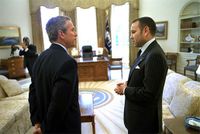
Morocco is a de jure constitutional monarchy with an elected parliament. The King of Morocco, with vast executive powers, can dissolve government and deploy the military, among other prerogatives. Opposition political parties are legal, and several have been formed in recent years.
Human rights and reforms
Morocco's history after independence and at the beginning of the reign of Hassan II was marked by a period of political tensions between the monarchy and opposition parties. Those years of tension are labeled by the opposition as the Years of Lead. Politically-motivated persecutions were common, especially when General Oufkir became responsible for home security.
However, during the last decade of the rule of King Hassan II, especially under the reign of Mohammed VI and with the launch of the Equity and Reconciliation Commission (IER) to investigate abuses committed in the name of the state, Morocco is trying to reconciliate with the victims. Many new laws and codes concerning all aspects of life are being or have been passed, most notable of which was the creation of the Mudawana — a family code which represented the first unique initiative of its kind in the Arab and Muslim world. The code gives women more rights. Other issues such as the abolition of capital punishment and the reform of the Moroccan nationality law are being debated. The Moroccan parliament is due to vote on these issues in spring 2007.
The 2003 Casablanca bombings and the need to fight the terrorist threat have led the government to pass a controversial anti-terrorism law that cracked down on terror suspects. Moroccan and international organizations continue to criticize the human rights situation in Morocco, mainly the arrests of suspected Islamist extremists during 2004 and 2005 in relation to the 2003 Casablanca bombings, and in Western Sahara.
In mid-February 2007, a study published by the Centre for Strategic and International Studies called "Arab Reform and Foreign Aid: Lessons from Morocco" concluded that Morocco provides a valuable lesson in political and economic reform, which others in the Arab world can draw on and that the Moroccan model confirms that it is possible to adopt both forms of reform simultaneously.
Regions and prefectures
Morocco is divided into 16 regions, and subdivided into 62 prefectures and provinces.
As part of a 1997 decentralization/regionalization law passed by the legislature, sixteen new regions were created. These regions are:
|
|
|
Western Sahara status
Because of the conflict over Western Sahara, the status of both regions of " Saguia el-Hamra" and " Río de Oro" is disputed.
The government of Morocco has suggested that a self-governing entity, through the Royal Advisory Council for Saharan Affairs (CORCAS), should govern the territory with some degree of autonomy for Western Sahara. The project was presented to the United Nations Security Council in mid-April 2007. The stalemating of the Moroccan proposal options has led the UN in the recent "Report of the UN Secretary-General" to ask the parties to enter into direct and unconditional negotiations to reach a mutually accepted political solution. The autonomy is rejected by the group Polisario which fought against the Spanish colonial rule and now for the Western Sahara decolonization with the name of Sahrawi Arab Democratic Republic.
Geography
At 172,402 sq.mi (446,550 sq.km), Morocco is the fifty-seventh largest country in the world (after Uzbekistan). It is comparable in size to Iraq, and is somewhat larger than the US state of California.
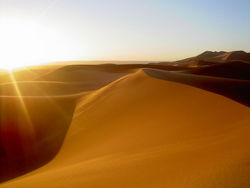
Algeria borders Morocco to the east and southeast though the border between the two countries has been closed since 1994. There are also four Spanish enclaves on the Mediterranean coast: Ceuta, Melilla, Peñón de Vélez de la Gomera, Peñón de Alhucemas, and the Chafarinas islands, as well as the disputed islet Perejil. Off the Atlantic coast the Canary Islands belong to Spain, whereas Madeira to the north is Portuguese. To the north, Morocco is bordered by and controls part of the Strait of Gibraltar, giving it power over the waterways in and out of the Mediterranean sea. The Rif mountains occupy the region bordering the Mediterranean from the north-west to the north-east. The Atlas Mountains run down the backbone of the country, from the south west to the north east. Most of the south east portion of the country is in the Sahara Desert and as such is generally sparsely populated and unproductive economically. Most of the population lives to the north of these mountains, while to the south is the desert. To the south, lies the Western Sahara, a former Spanish colony that was annexed by Morocco in 1975 (see Green March). Morocco claims that the Western Sahara is part of its territory and refers to that as its Southern Provinces.
Morocco's capital city is Rabat; its largest city is its main port, Casablanca.
Other cities include Agadir, Essaouira, Fes, Marrakech, Meknes, Mohammadia, Oujda, Ouarzazat, Safi, Salè, Tangier and Tétouan.
Climate
The climate is Mediterranean, which becomes more extreme towards the interior regions where it is mountainous. The terrain is such that the coastal plains are rich and accordingly, they comprise the backbone for agriculture. Forests cover about 12% of the land while arable land accounts for 18%. 5% is irrigated.
Wildlife
Morocco is known for its wildlife biodiversity. Birds represent the most important fauna. The avifauna of Morocco includes a total of 454 species, of which five have been introduced by humans, and 156 are rare or accidental.
Encoding
Morocco is represented in the ISO 3166-1 alpha-2 geographical encoding standard by the symbol MA. This code was used as the basis for Morocco's internet domain, .ma.
Economy
According to the African Development Bank, the GDP of Morocco accounts for 7% of the African continent. Morocco is the fifth economic power of Africa with a 2006 GDP of $152.5 billion at PPP ($58.1 billion at official exchange rates), after South Africa, Egypt, Algeria and Nigeria.(2001)
Morocco's largest industry is the mining of phosphates. Its second largest source of income is from nationals living abroad who transfer money to relatives living in Morocco. The country's third largest source of revenue is tourism; 7.45 million tourists visited the country in 2007.
Morocco ranks among the world’s largest producers and exporters of cannabis, and its cultivation and sale provide the economic base for much of the population of northern Morocco. The cannabis is typically processed into hashish. This activity represents about 0.5% of Morocco's Gross Domestic Product (GDP). A UN survey estimated cannabis cultivation at about 1,340 square kilometres (515 sq mi) in Morocco's five northern provinces. This represents 10 % of the total area and 27 per cent of the arable lands of the surveyed territory and 1.5 per cent of Morocco's total arable land. Morocco is a party to the 1988 UN Drug Convention and in 1992 Morocco passed legislation designed to implement the Convention.
Morocco has an unemployment rate of 7.7% (2006 Data) and a 1999 estimate by the CIA puts 19% of the Moroccan population under the poverty line..
Though working towards change, Morocco historically has utilized child labor on a large scale. In 1999, the Moroccan Government stated that over 500,000 children under the age of 15 were in the labor force.
Morocco has signed Free Trade Agreements with the European Union (to take effect 2010) and the United States of America. The United States Senate approved by a vote of 85 to 13, on July 22, 2004, the US-Morocco Free Trade Agreement, which will allow for 98% of the two-way trade of consumer and industrial products to be without tariffs. The agreement entered into force in January 2006.
Demographics
Morocco is the third most populous Arab country, after Egypt and Sudan. Most Moroccans are Sunni Muslims of Arab, Berber, or mixed Arab-Berber stock. About three-quarters of all present-day Moroccans are of Berber descent, while Arabs form the second largest ethnic group. The Arabs invaded Morocco in the seventh century and established their culture there.
There is no significant genetic difference between Moroccan Arabs and Moroccan non-Arabs (i.e. Berbers). Thus, it is likely that Arabization was mainly a cultural process without genetic replacement. However, according to the European Journal of Human Genetics, North-Western Africans were genetically closer to Iberians and to other Europeans than to sub-Saharan Africans.
Morocco's official language is classical Arabic. The country's distinctive Arabic dialect is called Moroccan Arabic. Approximately 12 million (40% of the population), mostly in rural areas, speak Berber – which exists in Morocco in three different dialects ( Tarifit, Tashelhiyt, and Tamazight) – either as a first language or bilingually with the spoken Arabic dialect. French, which remains Morocco's unofficial second language, is taught universally and still serves as Morocco's primary language of commerce and economics. It also is widely used in education and government. About 20,000 Moroccans in the northern part of the country speak Spanish as a second language in parallel with Tarifit. English, while still far behind French and Spanish in terms of number of speakers, is rapidly becoming the third foreign language of choice among educated youth (after Arabic and French). As a result of national education reforms entering into force in late 2002, English will be taught in all public schools from the fourth year on. French however, will remain the second foreign language because of Morocco's close economic and social links with other French-speaking countries and especially France.
Most people live west of the Atlas Mountains, a range that insulates the country from the Sahara Desert. Casablanca is the centre of commerce and industry and the leading port; Rabat is the seat of government; Tangier is the gateway to Morocco from Spain and also a major port; Fez is the cultural and religious center; and Marrakech is a major tourist centre.
There is a European expatriate population of 100,000, mainly of French or Spanish descent; many are teachers or technicians and more and more retirees, especially in Marrakech.
Education in Morocco is free and compulsory through primary school (age 15). Nevertheless, many children – particularly girls in rural areas – still do not attend school. The country's illiteracy rate has been stuck at around 50% for some years, but reaches as high as 90% among girls in rural regions. On September 2006, UNESCO awarded Morocco amongst other countries; Cuba, Pakistan, Rajasthan (India) and Turkey the "UNESCO 2006 Literacy Prize".
Morocco has about 230,000 students enrolled in fourteen public universities. The Mohammed V University in Rabat and Al Akhawayn University in Ifrane (a private university) are highly regarded. Al-Akhawayn, founded in 1993 by King Hassan II and King Fahd of Saudi Arabia, is an English-language American-style university comprising about 1,000 students. The University of Al Karaouine, in Fez, is considered the oldest university in the world and has been a centre of learning for more than 1,000 years.
Moroccan Jews
Morocco's Jewish minority has decreased significantly and numbers about 7,000 (see Jewish exodus from Arab lands). Prior to mass emigration, Morocco was home to more Jews than any other Muslim country in the world. The Jewish community of Morocco, which dates back more than 2,000 years, has experienced various waves of both tolerance and discrimination. The worst outbreaks of antisemitic violence occurred during the Middle Ages, when Jews were massacred in Fez in 1033 and in Marrakech in 1232. Following the establishment of the French protectorate in 1912, Jews began to enjoy greater equality.
Morrocan Jews are of two main stocks. One group is composed by those descended from the Jewish community of Spain (known as Sephardi Jews), who emigrated and settled in Morocco after a wave of anti-Jewish rioting in 1391, and especially after the expulsion of the Jews in 1492. An example of such a community was the Jewish population of Debdou, who constituted a majority of the town's population. The other grouping is Jews of indigenous descent, probably Berber converts to Judaism.
Transport
Military
The military of Morocco is composed of the following main divisions:
- Royal Armed Forces
- Army
- Navy
- Air Force
- Gendarmerie
- Auxiliary Forces
- Moroccan Royal Guard
- Marche Verte
Technology
- Casablanca Technopark
Universities
Sport
International rankings
- The 2002 Reporters Without Borders' worldwide press freedom index ranked Morocco 119th out of 167 countries.
- The Economist''s worldwide quality-of-life index 2005 PDF (67.1 KiB) ranked Morocco 65th out of 111 countries.
Affiliations
| Organization | Dates |
| United Nations | since November 12, 1956 |
| Arab League | since October 1, 1958 |
| International Olympic Committee | since 1959 |
| Organization of African Unity | co-founder May 25, 1963; withdrew November 12, 1984 |
| Group of 77 | since June 15, 1964 |
| Organization of the Islamic Conference | since September 22, 1969 |
| World Trade Organization | since January 1, 1995 |
| Mediterranean Dialogue group | since February 1995 |
| Major non-NATO ally of the United States | since January 19, 2004 |
Bilateral and multilateral agreements
- GAFTA
- Middle East Free Trade Area
- General Agreement on Tariffs and Trade
- Euro-Mediterranean free trade area
- US-Morocco Free Trade Agreement
Sufism
- Dar-Sirr.com: Portal to Moroccan Sufism


